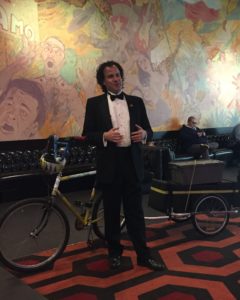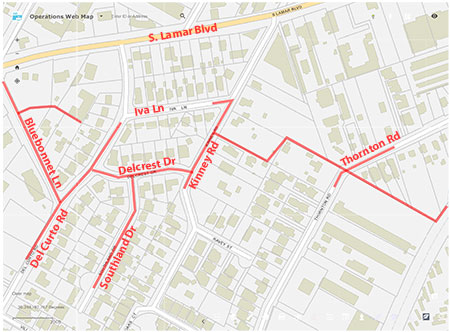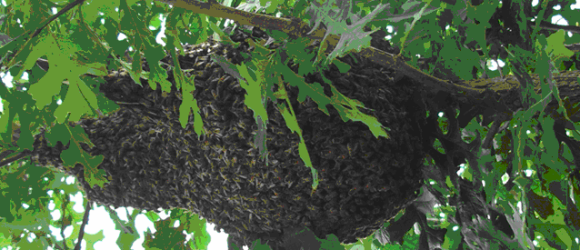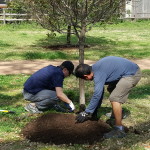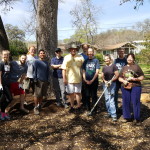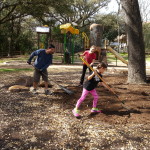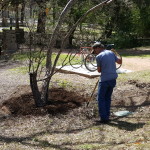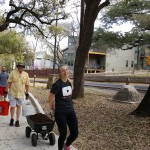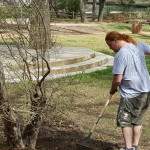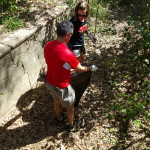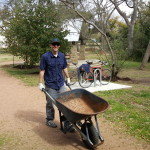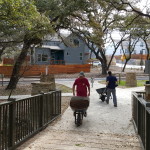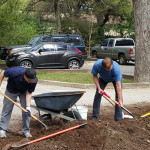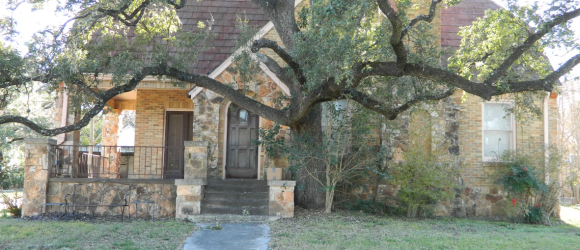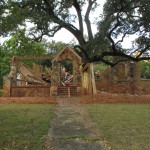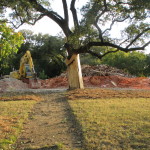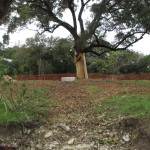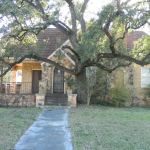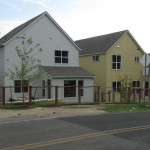Feb 15 Meeting Location Change
- At February 04, 2018
- By SLNA Admin
- In Uncategorized
 0
0
Austin Watershed Del Curto Drainage Project
On Tuesday, January 23, 2018 the Watershed Department gave a public presentation about the status of the Del Curto drainage project. This project is important to SLNA to mitigate the very real risk of flooding that currently exists. Homeowners and residents are strongly encouraged to read the materials and familiarize yourselves with this project to see the impacts it could have on you and your residence. Construction should begin in 2019 and the city will be buying drainage easements from some property owners:
An easement gives us the legal right to use a parcel of land for a specific and limited purpose. There are two purposes for a drainage easement. It may be needed to give rain water a place to flow. It may also be needed to install, access and maintain pipes to divert rain water. This prevents large amounts of water from accumulating during heavy rainfall. The area designated as a drainage easement is off limits for any use other than growing grass and planting flowers.
Information about the Del Curto Storm Drain improvements can be found at this site: http://www.austintexas.gov/department/del-curto-storm-drain-improvements-0
The Jan 23 presentation can be found here: https://southlamar.org/slna/wp-content/uploads/2018/01/Del_Curto_Presentation_01_18.pdf
Spring is buzzing!
- At April 09, 2017
- By SLNA Admin
- In Uncategorized
 0
0
Hello everyone, we hope you have been enjoying the fabulous spring weather! It’s hard to believe that Easter is already upon us, but here it is! There will be an Easter egg hunt at Del Curto park on Easter Sunday at 10 AM. We hope you and your little ones can get out to enjoy it.
A lot of things are buzzing in the neighborhood! Flowers and trees are gifting us with their beauty and their pollen. It looks like the Live Oaks are nearing the end of that cycle so perhaps the yellow hue can finally be washed off. We’ve got a lot of construction projects going on, and soon, hopefully very soon, we will have some sidewalks along Dead Man’s curve and on Thornton to help us get along more safely. Until that time, we really encourage everyone to be extra cautious due to the increase in traffic through the neighborhood. There will be a new stop sign on Dead Man’s curve as well, so please be alert to those changes. We regularly see pedestrians, cyclists, and speeding motorists on Clawson, Lightsey, Del Curto, and Thornton which is always a great concern. Please be careful out there!
Speaking of buzzing, I’ve noticed a lot of mosquitoes after the recent rains so it’s a very good time to remind everyone of the dangers they bring, and how to mitigate that. Please be on the lookout for standing water on your property. Buckets, flower pots, tires, even small flower pot trays can hold water and allow mosquitoes to spawn. There are a number of mosquito repellents available. Our Agrilife Extension agent, Wizzie Brown, wrote a recent newsletter addressing that we will include below for you.
Have a wonderful Spring season everyone!
From Wizzie Brown:
Mosquito Repellents
As mosquito season is ramping up, everyone is (hopefully) aware of possible disease transmission by mosquitoes. It is important that you protect yourself when spending time outside.
Activity times for mosquitoes can vary. Most people are familiar with the four D’s- DRAIN (standing water), DEET (wear some repellent), DUSK & DAWN (stay indoors during dusk and dawn to avoid peak populations) and DRESS (wear long sleeves and long pants). While this is still good advice, it may be a good idea to spread the dress and repellent advice for anytime you spend time outdoors.
When outside, wear long pants and a long sleeved shirt in light colors to reduce the number of mosquitoes that can reach your skin. Repellent should only be applied to clothing and exposed skin. Do not apply repellent underneath clothing! If you want to apply repellent to your face, spray your hands with repellent and rub it onto your face. Do not spray repellent directly into your face or near eyes or mouth. Make sure to apply repellent outdoors. Do not allow children to handle repellents. Wash hands before eating, smoking or using the restroom.
The Center for Disease Control (CDC) recommends using a product registered with the EPA (Environmental Protection Agency) containing one of the following active ingredients: DEET, picaridin, IR3535 and some of the products containing oil of lemon eucalyptus.
DEET, also known N,N-diethyl-m-toluamide or N,N-diemethylbenzamide, was developed by the U.S. Army in 1946 to protect soldiers in insect-infested areas. Pesticides containing DEET have been used by the general public since 1957. Products containing DEET should not be used on children younger than 2 months of age (read the label and check with your pediatrician if you have questions). DEET has a slight odor and may have a greasy feel to some people. It may damage plastic, rubber, vinyl or synthetic fabrics. DEET may be irritating to the eyes and skin for some people. DEET comes in a wide variety of concentrations, so choose the one that will work best for your situation.
Picaridin was first made in the 1980’s and resembles a natural compound called piperine (which is found in plants used to produce black pepper). Picardin has been used in Europe and Australia for many years, but has only been in the U.S. since 2005. Picaridin is non-greasy and is odorless.
IR-3535, or 3-[N-Butyl-N- acetyl]-aminopropionic acid, ethyl ester, was developed in the mid- 1970’s and became registered for use in the U.S. in 1999. It is registered as a biopesticide by the EPA because it is functionally identical to a naturally occurring substance (an amino-acid). It may dissolve or damage plastics and may be irritating to the eyes.
Oil of lemon eucalyptus (OLE) or PMD (para-menthane-3,8-diol) are essentially the same thing; PMD is the synthesized (lab created) version of oil of lemon eucalyptus. “Pure” or “essential” oil of lemon eucalyptus is not labeled as a repellent and has not undergone testing and should not be used as a repellent product. OLE/PMD has been on the market in the U.S. since 2002. OLE/PMD should not be used on children younger than 3 years of age. The natural product (OLE) has known allergens within it while the synthetic version (PMD) has less of a risk to allergens. This product is classified as a biopesticide. OLE/PMD has a varying range of residual, some offering about 20 minutes of protection while other products may last up to two hours.
Many factors play into how long a repellent will last for a person. Some of these are:
- The concentration (or percent of active ingredient) of the product. You can find the percentage on the product label.
- Person’s attractiveness. Some people are more attractive to mosquitoes than others (and no scientific research has proven that it is because of eating garlic, taking vitamin B, using tobacco products, etc.). A person’s genetic code plays a large part on what makes a person so attractive to mosquitoes.
- Frequency and uniformity of application. In other words, how often is the repellent applied and how good of coverage did you get?
- Activity level of the person. The more active the person is, the more sweat they produce which can cause the repellent to wash off the surface of the skin.
As a word of caution, there are products that combine sunscreen and insect repellent. The CDC recommends that if you need sunscreen and repellent, that you choose two separate products. Sunscreen should be applied more often than repellents.
For more information or help with identification, contact Wizzie Brown, Texas AgriLife Extension Service Program Specialist at 512.854.9600. Check out my blog at www.urban-ipm.blogspot.com
The information given herein is for educational purposes only. Reference to commercial products or trade names is made with the understanding that no discrimination is intended and no endorsement by Texas A&M AgriLife Extension Service or the Texas A&M AgriLife Research is implied.
The Texas A&M AgriLife Extension Service provides equal access in its programs, activities, education and employment, without regard to race, color, sex, religion, national origin, disability, age, genetic information, veteran status, sexual orientation or gender identity.
Happy Fall!
- At September 26, 2016
- By SLNA Admin
- In Uncategorized
 0
0
We made it through another summer, y’all! No more 100+ degree days. Maybe, just maybe (if the construction noise and dust aren’t too bad) we’ll be able to open the windows again soon. Fall is here and it’s a great time to get outside to our local parks, including our SLNA neighborhood park on Del Curto.
Maybe you’ve noticed the explosion of butterflies in the air. Fall is a really great time to plant nectar plants for next year, including those to help the monarchs. Check out these two articles from the Lady Bird Johnson Wildflower center and Wizzie Brown our Extension Agent Specialist, that talk about butterflies.
Enjoy the cooler weather!
It Takes a Landscape: Fall Nectar Plants Could Save Monarchs
http://urban-ipm.blogspot.com/2016/09/have-you-seen-me-snout-butterflies.html
Honey Bee Swarm Season
- At March 14, 2016
- By SLNA Admin
- In Nature
 0
0
Add this to the March excitement of Spring Break and SXSW – it’s honey bee swarm season! At least honey bees don’t add to our traffic woes. Our IPM Program Specialist, Wizzie Brown, clues us in to what’s happening with honey bees in the spring time, and what to watch out for. Let us know if you spot any swarms in the neighborhood!
Honey bee swarms
Honey bees are beneficial by producing honey, wax and pollinating crops. With warmer temperatures, honey bees are becoming more active and may soon begin to swarm.
Honey bee swarms look like a large clump of bees clustered together. The swarm may stay in a location from a few hours to a week. Swarms are produced as a part of the colony’s reproductive process. An established colony produces a new queen, causing the old queen and half the worker bees to leave the colony to search for a new nesting location. Swarming honey bees are usually gentle and unlikely to sting. Swarms are not protecting their home, food or offspring. Scout bees are sent out from the swarm to search for a nesting site. Colonies produce comb and honey and are defensive. Bees from a colony are more likely to sting as they are guarding their home, food and offspring.
Sometimes, honey bee colonies can be found in wall voids, chimneys, attics or sheds. If bees are in a wall void, DO NOT block their entrance; this makes them search for another way to exit and could lead bees into the structure. To keep bees from entering a home, seal any holes found in walls where pipes enter the home, cracks in window framing, knotholes, weep holes, or cracks between wood and brick junctures.
While many enjoy having honey bees around, some people are severely allergic to their venom. This, along with other situations, such as bees located near sensitive areas (such as playgrounds) may require removal or even extermination of the bees.
People should NOT try remove or exterminate bees on their own. Beekeepers and pest control companies have equipment to carry out these jobs in a safe manner. The city or county does not provide bee removal services.
For more information or help with identification, contact Wizzie Brown, Texas AgriLife Extension Service Program Specialist at 512.854.9600. Check out my blog at www.urban-ipm.blogspot.com
It’s My Park Day
This past Saturday we had many volunteers meet up at our neighborhood park for “It’s My Park Day”. The weather could not have been better! The hearty crew spread mulch around trees and did some trash pick-up. In addition to enjoying some good snacks and t-shirt schwag, we were visited by Council member Ann Kitchen. Thanks to J Rhatigan for organizing the effort and thanks to all who lent a hand to help our park!
West Bouldin Watershed Del Curto Storm Drain Improvement Project – Update
We received the following update from the City of Austin about the Del Curto Storm Drain improvements. Visit this link for the background information about this project.

We are entering into the “Design Phase” for the Del Curto Storm Drain Project.
During design, our engineering consultant will be working out all the details of the proposed project. The design phase ends with a set of construction plans that will be used to permit, bid and construct the project. The project¹s goal is to allow storm water to flow safely to West Bouldin Creek through a combination of underground pipes and open channels. The water will enter West Bouldin Creek near Thornton.
The project will include the following components:
Bluebonnet Lane
We will install curb and gutter along a short stretch of Bluebonnet Lane where there is currently none. The area is between Del Curto Road and South Lamar Boulevard. Curb and gutter can help keep storm water in the street.
Storm Drain Bypass
We will install an underground pipe and associated inlets on part of Bluebonnet Lane, Del Curto Road, Delcrest Drive and Kinney Road. The bypass pipe will capture rainwater and release it into the channel that runs between Kinney and Thornton.
Channel Enhancement
We will increase the capacity of the channel between Kinney and Thornton. This could include making the channel wider or deeper or other options.
Storm Drain Conveyance from Thornton to West Bouldin Creek
After storm water flows through the channel between Kinney and Thornton, it crosses Thornton and flows overland into West Bouldin Creek. We will provide a path for the water to take across this area. It could take the form of a pipe or improvements to the channel or some combination.
Easements
We will acquire drainage easements at various locations in the project area. Drainage easements are a designated place for water to flow during storms. In some cases, they are also needed for access or maintenance of the drainage system.
Green Streets Component Dropped
During the internal review of this project, it was decided not to pursue the Green Streets initiative on Iva and Delcrest that was presented at the public meeting in September. This option would have improved water quality, but not the flooding.
Timeline
The internal review took longer than we initially thought. We are currently expecting to start construction in the summer of 2017. This assumes that the easement acquisition process goes smoothly.
Zika Virus
- At February 14, 2016
- By SLNA Admin
- In City of Austin, Nature
 0
0
The Zika Virus is making the news as it is rapidly spreading throughout South, Central, and now into North America. Our IPM Program Specialist, Wizzie Brown, recently blogged about the virus in her “Urban IPM” blog: http://urban-ipm.blogspot.com/
IPM stands for “Integrated Pest Management”, and Wizzie’s job through the Texas A&M AgriLife Extension service is to help manage our urban insects – everything from ants, termites, and aphids to butterflies and honey bees … you name it. She helps us understand the beneficial insects and how to manage those that aren’t. Wizzie is a great resource for us.
We encourage everyone to read Wizzie’s blog and the references that she cites for more information about Zika.
As a neighborhood, we can do a lot to protect ourselves from this virus by being vigilant against standing water. Please empty any containers that collect water so mosquitoes don’t have a breeding ground. Look for anything in your yard that holds even the smallest amount of water such as buckets, flower pot trays, tarps, old tires, vehicles, boats, kayaks, etc. If you see standing water on city property, please call 311 to report it. Go on a mosquito safari in your own back yard with the folks at Texas A&M: http://mosquitosafari.tamu.edu/
Lightsey Home Demolition
Early last month the Lightsey home at 1805 Lightsey Road was torn down to make way for approximately 31 new homes to be built by PSW Real Estate. The Lightsey home was built in 1932 and sat prominently with a view of downtown at the highest point in the neighborhood. It was located near the intersection of Del Curto and Lightsey (also known as Dead Man’s Curve) which is very close to the geographic center of SLNA.
Over the past year the Lightsey home historic zoning case was heard many times including at the Historic Landmark Commission on March 23rd, the Planning Commission on June 23rd, and lastly at City Council on August 13. Despite the Historic Zoning Commission having voted 4-1 to initiate historic zoning, City Council voted 5-5-1 not to preserve the home. Council members Tovo, Pool, Garza, Casar and Kitchen voted for preserving the home; Houston, Zimmerman, Troxclair, Renteria, and Adler voted against; and Gallo abstained. The preservation of the Lightsey home was overwhelmingly supported by members of the neighborhood, and Council member Ann Kitchen (our District 5 representative) vigorously advocated saving the home. However, the arguments largely fell on deaf ears at City Council.
PSW has said numerous times that if given the demolition permit, they will reuse material from the Lightsey home as site features around some of the heritage trees and especially at the entry along Lightsey Road (http://austintx.swagit.com/play/06232015-880/2/ Item C7 @44:08). This diagram shows the location of some of these features:
Specifically PSW has said:
- We will fully document the existing home; Pictures of each façade and pertinent architectural details, dimensioned site plan existing structure, and historic narrative of the property and its residents
- We are willing to use materials/elements in a site feature that evokes the feeling of the architecture of the existing home
- Use stone from existing home in the tree wells and retaining walls along the Aldwyche Dr extension
We are very much looking forward to seeing the creative ways PSW fulfulls their promise of reusing the materials salvaged from the Lightsey home. We cannot overstate the importance of developers trying to preserve some of the original character of SLNA, so much of which has sadly been lost in recent years.
During the course of hearings defending the demolition of the historic home, PSW’s representative Glen Coleman said that while they appreciate wanting to honor history, “Think about the history we are making”. Making history? Time will tell, Mr. Coleman, time will tell.

